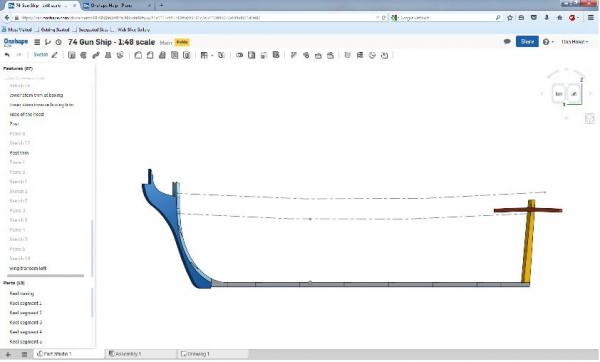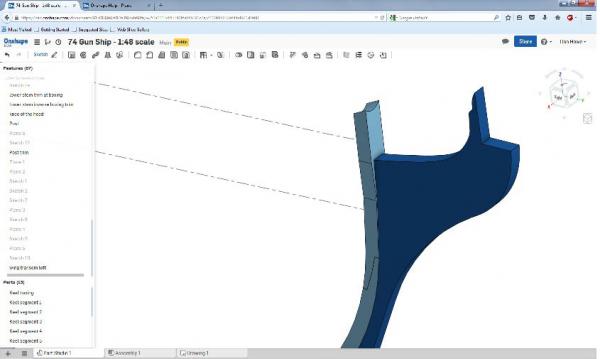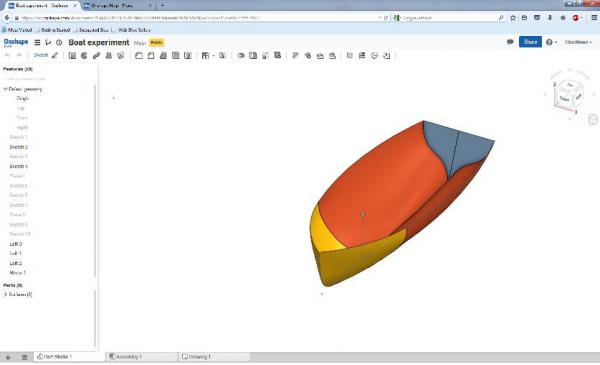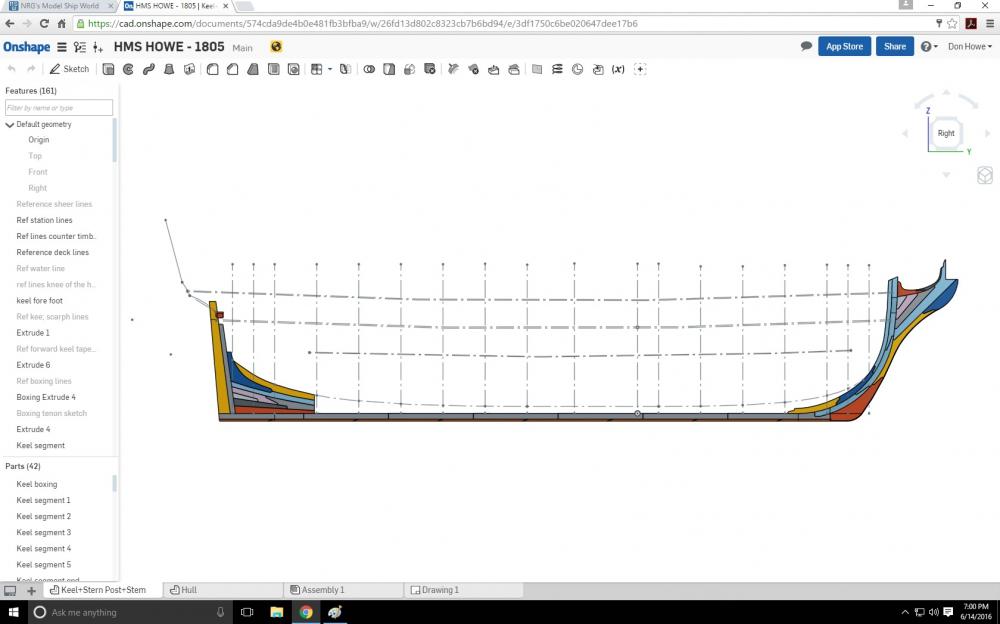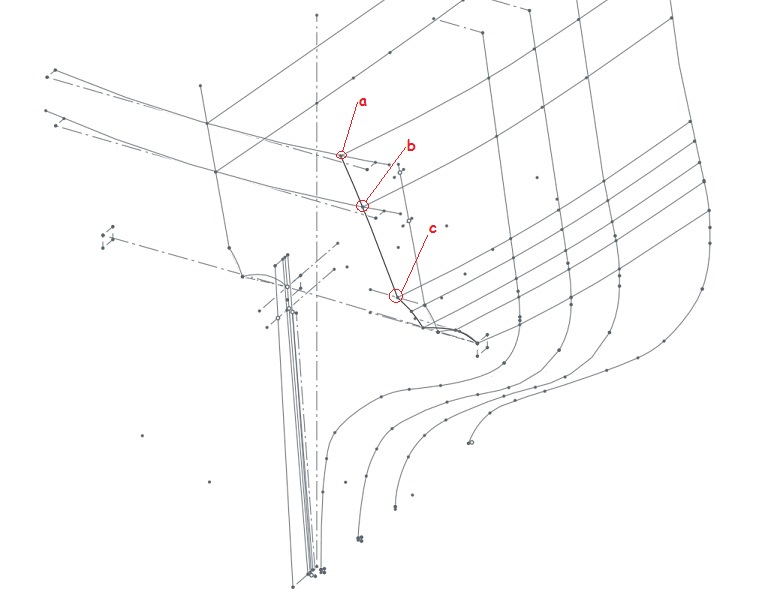-
Posts
718 -
Joined
-
Last visited
Content Type
Profiles
Forums
Gallery
Events
Everything posted by Don9of11
-
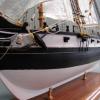
Fusion 360
Don9of11 replied to Williamo's topic in CAD and 3D Modelling/Drafting Plans with Software
Onshape limits you to 10 private files. If you make your files public you have 5 gb of storage. I like your launch Wayne, I think Fusion 360 has better rendering than the Turbo cad. I also think you have a good definition of whole molding that is very few Bezier curves. -

Fusion 360
Don9of11 replied to Williamo's topic in CAD and 3D Modelling/Drafting Plans with Software
I use Onshape exclusively for my ship design and woodshop projects. There are tons of tutorials to get you started. If you are already familiar with 3D modeling you'll pick up on things pretty quickly if not the tutorials are very good. There is no software to download. You can signup for a free account or paid subscription. I've inserts a few screen shots. Hope this helps. -

Fusion 360
Don9of11 replied to Williamo's topic in CAD and 3D Modelling/Drafting Plans with Software
You might also take a look at Onshape. It's cloud based, with a free and paid subscription. Created by the original Solidworks developers. -
I came across this article on the HMS Implacable a 74 gun ship. I follow WoodenBoat on FB and this is how i came to know about it, thought I would share. There are several you tube videos you can watch if you search. https://www.greenwich.co.uk/blogs/
-
Nice renders. The hand over hand for pulling rope doesn't seem quite right.
-
I would recommend Onshape it's free or you can pay either way the full use of the software is at your disposal. It's also cloud based which means a group collaboration is possible. Its a lot like SW but different to. There is no software to down load and it runs on pc, Mac, and various mobile devices. I'm using it now to design a 74 gun ship based mostly on Steel's work but other resources as well. Designing a ship of this complexity from scratch has been a challenge but also rewarding. I work on it during evenings, weekends and when the spirit moves me, not necessarily in that order. That being said, it's been a couple years in the making and I'm not done. A couple screen shots is below.. I have post on the forum called "scantling questions" which documents my progress.
-

question for sketchup users
Don9of11 replied to hamilton's topic in CAD and 3D Modelling/Drafting Plans with Software
I also tried Sketchup for drawing ship plans but found it lacking in many areas as was mentioned lack of splines and problems with circles, bevels and few other things. I have a post with my efforts somewhere on forum; at first it seems easy, feasible and I progressed up to a certain point and began to encounter difficulty do to a lack of tools. Im not new to 3D as I've been a Solidworks user for a long time. I agree with Alex, I don't think Sketchup is well suited for drawing up plans. I've been recommending Onshape which is free for 3D modeling. It's a lot like SW so the learning curve was small. Search for a post called scantling questions. -
Check your local high school or middle school and see if they have any vocational classes in drafting or machine shop. The likely will have some old books, better yet check your local library. Depending on your software there are probably oodles of YouTube videos to help you get started. You have a lofty goal and drawing plans from scratch isn't for the faint of heart. Tracing over an existing set of plans might be better as you'll have something to work from and learn a long way what will be expected of you when drawing from scratch.
-

Swan class 3D model in progress
Don9of11 replied to dvm27's topic in CAD and 3D Modelling/Drafting Plans with Software
Amazing detail! Good job, keep the pics coming.- 141 replies
-
- pof swan series
- swan
-
(and 1 more)
Tagged with:
-

Yet Another Pandora 3D build
Don9of11 replied to herask's topic in CAD and 3D Modelling/Drafting Plans with Software
Nice detail Denis. I like the first group of photos with the natural wood look but the sun light looks awesome too.- 119 replies
-

Yet Another Pandora 3D build
Don9of11 replied to herask's topic in CAD and 3D Modelling/Drafting Plans with Software
I'm not sure Mark. The book I mentioned covers construction in good detail.- 119 replies
-

Yet Another Pandora 3D build
Don9of11 replied to herask's topic in CAD and 3D Modelling/Drafting Plans with Software
Looking good Denis. Another resource you could look for is "The Construction and Fitting of the English Man of War: 1650-1850" by Peter Goodwin. You might find a good used copy online, maybe Abe books, even Amazon.- 119 replies
-

Yet Another Pandora 3D build
Don9of11 replied to herask's topic in CAD and 3D Modelling/Drafting Plans with Software
What you have circled is called the deadwood knee. The wood that you're looking at on the plans is called deadwood. I discussed this in my post Scantling questions. It starts about half way down the page. The best thing to do is take a look at some contemporary builds, try searching the scratch build section of the forum, HMS Bellerophon comes to mind but there are others.- 119 replies
-

Yet Another Pandora 3D build
Don9of11 replied to herask's topic in CAD and 3D Modelling/Drafting Plans with Software
I think they are called "chocks" but I could be wrong. Check out the scratch build forum or do a search for HMS Bellerophon which is a 74 gun ship. I remember reading something there about them. There is another e-book you could download that is a smaller version of the big Steel book. It called the Shipwrights Vade Mecum by the same author. There is a definition of terms in both e-books.- 119 replies
-

Yet Another Pandora 3D build
Don9of11 replied to herask's topic in CAD and 3D Modelling/Drafting Plans with Software
Denis, the scanned plans are probably not to scale or have other issues such as stretching or shrinking. Your frame plan probably didn't match up exactly with the deck plans or there could be other issues. Are these the plans from the Anatomy of the Ship series? Either way, based on what I see I would proceed as you suggested. As long as you are confident that your hull is fair then manipulate the plans to fit your hull. There is going to be a certain amount of guess work involved so I wouldn't worry to much about it. Accuracy can be a double-edge-sword when using CAD or similar programs, just remember to think like you were really building the model and a little sanding here or there can equal inches real life. For example, if you're modeling in 1/4 scale, 1 inch is equal to about 0.021 inches, 6 inches equal to 0.125 inches and so on. You're doing a great job, keep up the good work!- 119 replies
-

Software recommendations
Don9of11 replied to Sailor1234567890's topic in CAD and 3D Modelling/Drafting Plans with Software
Check out Onshape, it's free, cloud based, 3D, Mac, PC, Android or iPhone. Easy to learn, plenty of tutorials, and help forums. I've been using Onshape exclusively to model my 74 gun ship (since I don't have access to Solidworks anymore) with good results. https://www.onshape.com/ I pretty sure this link will let anyone on MSW have a "view only" of my model without having an Onshape account (left mouse click to rotate the model using PC) Also, I think the link is time sensitive but I'm not really sure. https://cad.onshape.com/documents/57ea50c5d91ac010bb7be5b1/w/79d07ad0512a48804ab65584/e/2f785a9bc8574c4df5bea0f3 -

Yet Another Pandora 3D build
Don9of11 replied to herask's topic in CAD and 3D Modelling/Drafting Plans with Software
The holes in the front are called "hawse holes". Very nice work Denis, keep the pcs coming. As far as frame thicknesses you mentioned earlier there is free Google e-book you can download load which has a lot of the information you can use. Steel, David. 1812. The Elements and Practice of Naval Architecture; Or: A Treatise on Ship-Building, Theoretical and Practical, on the Best Principles Established in Great Britain. With Copious Tables of Dimensions, &c. Illustrated with a Series of Thirty-Nine Large Draughts, ... Steel and Company.https://books.google.com/books?id=TWsmw-QqvmAC Also, you might check out Seawhatch books website. https://www.seawatchbooks.com/- 119 replies
-

Where is the deck?
Don9of11 replied to rhephner's topic in CAD and 3D Modelling/Drafting Plans with Software
You might want to try the http://www.floatingdrydock.com/ they have a much better selection of plans and e-books of the Fletcher class. You can also check out my gallery http://modelshipworld.com/index.php/gallery/album/60-uss-zellars-dd-777/ and my progress build photos located here http://howefamily.com/zellars_progress_photos/zellars.asp(flash required) My build is a Sumner class which is a little different than the Fletcher but the hull shape is essentially the same. I believe the Fletcher, Gearing and Sumner classes all had flush decks. Another great source for this and other US Navy plans go to the following: https://maritime.org/doc/plans/ hope that helps -
This is an interesting post as I have often wondered about my own 74 project and plans I'm developing, where I am following the information found in the Shipwrights Vade Mecum as the principal source, Ree's Naval Architecture and others. Some of these sources are public domain and I'm not tracing or copying from any existing drawings but drafting everything from scratch. A very interesting topic indeed.
-

How to deal with badly drawn plans?
Don9of11 replied to Redshirt's topic in CAD and 3D Modelling/Drafting Plans with Software
I'm not that familiar with Adobe Illustrator but as with any software there is a learning curve. It might be best to work on something simple until you learn where the tools are that you will need. As far as the file size and depending on how large the image or pdf might be, you could import small sections, draw them and slowly piece your drawing together.
About us
Modelshipworld - Advancing Ship Modeling through Research
SSL Secured
Your security is important for us so this Website is SSL-Secured
NRG Mailing Address
Nautical Research Guild
237 South Lincoln Street
Westmont IL, 60559-1917
Model Ship World ® and the MSW logo are Registered Trademarks, and belong to the Nautical Research Guild (United States Patent and Trademark Office: No. 6,929,264 & No. 6,929,274, registered Dec. 20, 2022)
Helpful Links
About the NRG
If you enjoy building ship models that are historically accurate as well as beautiful, then The Nautical Research Guild (NRG) is just right for you.
The Guild is a non-profit educational organization whose mission is to “Advance Ship Modeling Through Research”. We provide support to our members in their efforts to raise the quality of their model ships.
The Nautical Research Guild has published our world-renowned quarterly magazine, The Nautical Research Journal, since 1955. The pages of the Journal are full of articles by accomplished ship modelers who show you how they create those exquisite details on their models, and by maritime historians who show you the correct details to build. The Journal is available in both print and digital editions. Go to the NRG web site (www.thenrg.org) to download a complimentary digital copy of the Journal. The NRG also publishes plan sets, books and compilations of back issues of the Journal and the former Ships in Scale and Model Ship Builder magazines.



